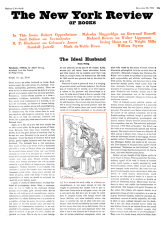Gordon Parks is a staff photographer for Life who recently published in that magazine a camera essay about the Black Muslims and a moving reminiscence of his boyhood in a Kansas border village during the 1920’s. The pictures of the latter essay are accompanied by excerpts from The Learning Tree, a first novel in which Mr. Parks creates a fictional construction of his early years on the American prairie.
For a story of American Negro life the setting of “Cherokee Flats,” Kansas, is unusual. In other respects the novel is deep in the American grain. A successful and mature American looks back at his own impoverished, underprivileged childhood in order to discern the significant forces, events, and choices which carried him away from the threat of mediocrity and failure and set him moving, however tensely and tentatively, toward security and accomplishment. In a sense this story is always the same for all Americans, whether black or white, who survive the gauntlet of an upbringing in this extra-ordinary country. (We say “Where do you come from?” meaning “How did you manage to get here?”) And in a sense the story is always unique, because the textures of American experience are so diverse, the routes of escape from ignominy so variable and unexpected.
Newt Winger, the twelve-year-old hero of The Learning Tree, inhabits a world of melodramatic violence—the first four chapters contain accounts of a cyclone, a savage beating, a fatal shooting, a drunken assault, an automobile crash which kills two people—and he inhabits a world where all moral issues are drawn in a stark opposition of black and white. Whereas the melodrama and the brutal simplification of morality stem from the myth of Negro inferiority imposed upon the town by the dominant white majority, violence, either threatened or actually inflicted, is the social mechanism employed by the whites to keep their power and privileges intact. Newt’s problems in growing up are manifold. He must eschew a countering violence which can only lead to a deeper entrapment; he must come to an understanding of society and of himself in terms other than those offered by the prevailing racist myth; somehow he must keep alive and sane in an environment that is both physically dangerous and emotionally disintegrative, while he picks up the second-class education which the town allots to its Negro children; and he must avoid settling into the attitudes of brooding hatred or of “shiftless” indifference which have always been available to colored people in this country as masks for a profound despair.
Newt survives and succeeds because he is brave, gifted, energetic, and because he is helped. His parents, the matriarchal Sarah and the silent, industrious Jack, are towers of strength. A few white people show him that love between the two races can exist, and the very openness of the prairie, its enormous sky and its lack of natural boundaries, suggest that a career commensurate with his talents and dreams remains somehow open to him. While a second Negro boy, the sullen and neglected Marcus, is drawn inexorably into a pattern of delinquency that leads to his own death, Newt approaches and surmounts a challenge decisive to his future as a decent human being. He has secret knowledge that a Negro has committed a murder for which a white man has been indicted. Were he to go to the authorities a race riot might ensue, since the murder victim is also white. In the end he does go because he cares passionately for the well-being of the community as a whole and rejects the idea that his only allegiance is to the exploited Negro minority.
Mr. Parks is scarcely a professional novelist. He can be preachy and sentimental and some of his characterizations are unconvincing. Nevertheless, for what it tells about the complex fate of being a colored American juvenile in this century, The Learning Tree is about a hundred times more interesting than the standard sagas of sensitive middle-class youth which the publishers visit upon us season after season.
Miss Brophy’s Flesh is complacently professional, altogether tiresome and, blessedly, quite short. Marcus and Nancy are a youngish middle-class Jewish couple of northwest London antecedents who marry and take up residence in a Chelsea flat. Nancy, we are told—everything is told by an intrusive narrator whose opinions I could find no compelling reason to accept—is good at sex and finds an apt pupil in the virginal and vaguely artistic Marcus. Their marriage becomes a penetration into grossness. After Nancy gets pregnant her features grow coarse. Marcus eats too much, grows breasts, fiddles about in the antique business, and has the beautiful German au pair girl on the floor of the flat while his wife is out at work. On the last page man and wife are at it again, this time on the sofa, the wife’s disgust at her husband’s corpulence adding a particular thrill.
Advertisement
No doubt for a number of people marriage is a protracted running to physical and spiritual seed. But why lay this sin at the door of a couple that the novel repeatedly, but never believably, categorizes as archetypal “North Londoners”—an expression apparently employed by anti-semitic household servants and other ignoramuses as a circumlocution for Jews? Anyway, I am suspicious of a book in which the principal characters, even though they first meet at a large party, seem to have no friends capable of either visiting them or hazarding an opinion about them, and whose parents and other relatives preserve unbroken silence about most of the events that occur. Perhaps it is all à clef and calculated to produce ripples of knowing gossip in the circle of Miss Brophy’s admirers. I confess I am not one of them. Her book is memorable to me only because halfway through reading it I was seized with a cramping suspicion that the novel as a viable literary form might after three hundred years of life be ready for burial.
This Issue
September 26, 1963



